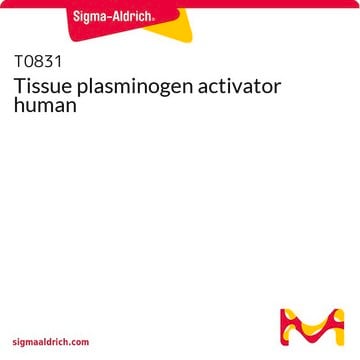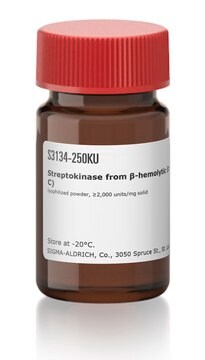P9156
Plasminogen from bovine plasma
lyophilized powder, ≥2.0 units/mg protein
Synonym(s):
Profibrinolysin
Sign Into View Organizational & Contract Pricing
All Photos(4)
About This Item
CAS Number:
EC Number:
MDL number:
UNSPSC Code:
12352202
eCl@ss:
42030240
NACRES:
NA.61
Recommended Products
biological source
bovine plasma
form
lyophilized powder
specific activity
≥2.0 units/mg protein
concentration
2-7% protein (biuret)
suitability
not suitable for streptokinase determination by clot formation procedure
application(s)
histology
storage temp.
2-8°C
Gene Information
cow ... PLG(280897)
human ... PLG(5340)
Biochem/physiol Actions
The activated form of plasminogen, plasmin, was shown to promote the migration of melanoma and lung tumor cells plated on the extracellular matrix protein laminin by altering protein kinase C signaling.
Plasminogen is the inactive precursor of the protease plasmin. Plasminogen is activated by the action of either tissue plasminogen activator (tPA), which primarily activates the fibrinolytic (thrombolytic) activity of plasmin, or urokinase plasminogen activator (uPA), which is associated with extracellular matrix remodeling and cell migration. Plasmin cleaves fibrin/fibrinogen and blood coagulation factors V/Va and VIII/VIIIa. It activates matrix metalloproteinases by cleaving the inactive proenzymes. It is also involved in the activation of some growth factors, such as vascular endothelial growth factor (VEGF) and transforming growth factor β (TGF-β).
Other Notes
ε-Aminocaproic acid free
Unit Definition
One unit will produce 1.0 μmole of p-nitroanilide from D-Val-Leu-Lys 4-nitroanilide at pH 7.5 at 37°C.
Physical form
Lyophilized powder containing NaCl, EDTA, lysine, and Tris buffer salts
Reconstitution
Solutions should be stored in buffer containing 20 mM lysine at neutral pH. The protein should be as concentrated as possible. Frozen in aliquots at −20 °C, it should be stable for several weeks.
Storage Class Code
11 - Combustible Solids
WGK
WGK 3
Flash Point(F)
Not applicable
Flash Point(C)
Not applicable
Personal Protective Equipment
dust mask type N95 (US), Eyeshields, Gloves
Certificates of Analysis (COA)
Search for Certificates of Analysis (COA) by entering the products Lot/Batch Number. Lot and Batch Numbers can be found on a product’s label following the words ‘Lot’ or ‘Batch’.
Already Own This Product?
Find documentation for the products that you have recently purchased in the Document Library.
Customers Also Viewed
L Chikahisa et al.
Invasion & metastasis, 17(6), 323-333 (1997-01-01)
Using a pure chemotactic model, we investigated the effect of plasmin on tumor cell motility. In the presence of various extracellular matrix proteins, plasmin facilitated motility of human melanoma LOX and lung cancer Lu-99 cells. Laminin contributed most to the
Yueling Zhang et al.
FEBS letters, 587(9), 1304-1309 (2013-03-12)
Cluster 1 streptokinases (SK1) from Streptococcus pyogenes (GAS) show substantially higher human plasminogen (hPg) activation activities and tighter hPg binding affinities than cluster 2b streptokinases (SK2b) in solution. The extent to which the different domains of SK are responsible for
Barbara Ruszkowska et al.
Acta obstetricia et gynecologica Scandinavica, 92(7), 841-846 (2013-03-12)
To assess the concentration of adiponectin, soluble E-selectin, soluble thrombomodulin and tissue activator plasminogen antigen in postmenopausal women who received oral or transdermal hormone therapy. Case-control study. Polish university hospitals. Seventy-six healthy postmenopausal women. Forty-six women who received oral (n
Eri Kawashita et al.
Journal of neurochemistry, 126(1), 58-69 (2013-05-08)
The α2-Antiplasmin (α2AP) protein is known as a principal physiological inhibitor of plasmin, but we previously demonstrated that it acts as a regulatory factor for cellular functions independent of plasmin. α2AP is highly expressed in the hippocampus, suggesting a potential
Deepa Gautam et al.
Frontiers in cell and developmental biology, 10, 834016-834016 (2022-04-08)
Prion peptide (PrP) misfolds to infectious scrapie isoform, the β pleat-rich insoluble fibrils responsible for neurodegeneration and fatal conformational diseases in humans. The amino acid sequence 106-126 from prion proteins, PrP(106-126), is highly amyloidogenic and implicated in prion-induced pathologies. Here
Our team of scientists has experience in all areas of research including Life Science, Material Science, Chemical Synthesis, Chromatography, Analytical and many others.
Contact Technical Service








